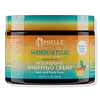What's inside
What's inside
 Key Ingredients
Key Ingredients

No key ingredients
 Benefits
Benefits

 Concerns
Concerns

 Ingredients Side-by-side
Ingredients Side-by-side

Water
Skin ConditioningPrunus Amygdalus Dulcis Oil
Skin ConditioningStearic Acid
CleansingStearyl Alcohol
EmollientCetearyl Alcohol
EmollientCetrimonium Chloride
AntimicrobialCetyl Alcohol
EmollientDimethicone
EmollientSteareth-21
CleansingSteareth-2
EmulsifyingAminomethyl Propanol
BufferingPolysorbate 20
EmulsifyingVaccinium Myrtillus Fruit/Leaf Extract
AstringentSaccharum Officinarum Extract
MoisturisingCitrus Aurantium Dulcis Fruit Extract
MaskingCitrus Limon Fruit Extract
MaskingAcer Saccharum Extract
Skin ConditioningMangifera Indica Seed Butter
Skin ConditioningOcimum Americanum Leaf Oil
MaskingLavandula Angustifolia Oil
MaskingAloe Barbadensis Leaf Juice
Skin ConditioningMelaleuca Alternifolia Leaf Oil
AntioxidantPhenoxyethanol
PreservativeEthylhexylglycerin
Skin ConditioningParfum
MaskingWater, Prunus Amygdalus Dulcis Oil, Stearic Acid, Stearyl Alcohol, Cetearyl Alcohol, Cetrimonium Chloride, Cetyl Alcohol, Dimethicone, Steareth-21, Steareth-2, Aminomethyl Propanol, Polysorbate 20, Vaccinium Myrtillus Fruit/Leaf Extract, Saccharum Officinarum Extract, Citrus Aurantium Dulcis Fruit Extract, Citrus Limon Fruit Extract, Acer Saccharum Extract, Mangifera Indica Seed Butter, Ocimum Americanum Leaf Oil, Lavandula Angustifolia Oil, Aloe Barbadensis Leaf Juice, Melaleuca Alternifolia Leaf Oil, Phenoxyethanol, Ethylhexylglycerin, Parfum
Water
Skin ConditioningPropylene Glycol
HumectantTriethanolamine
BufferingPolyacrylamidomethylpropane Sulfonic Acid
Vinyl Caprolactam/Vp/Dimethylaminoethyl Methacrylate Copolymer
Skin ConditioningPolysorbate 20
EmulsifyingBenzyl Alcohol
PerfumingDimethicone
EmollientEthylhexyl Methoxycinnamate
UV AbsorberPanthenol
Skin ConditioningAcrylates/C10-30 Alkyl Acrylate Crosspolymer
Emulsion StabilisingPolyquaternium-28
Citric Acid
BufferingGlycerin
HumectantParfum
MaskingSodium Benzoate
MaskingHydroxypropyltrimonium Hydrolyzed Wheat Protein
Skin ConditioningPrunus Amygdalus Dulcis Seed Extract
Skin ConditioningMica
Cosmetic ColorantTetrasodium Glutamate Diacetate
Titanium Dioxide
Cosmetic ColorantPhenoxyethanol
PreservativeCaprylyl Glycol
EmollientLimonene
PerfumingWater, Propylene Glycol, Triethanolamine, Polyacrylamidomethylpropane Sulfonic Acid, Vinyl Caprolactam/Vp/Dimethylaminoethyl Methacrylate Copolymer, Polysorbate 20, Benzyl Alcohol, Dimethicone, Ethylhexyl Methoxycinnamate, Panthenol, Acrylates/C10-30 Alkyl Acrylate Crosspolymer, Polyquaternium-28, Citric Acid, Glycerin, Parfum, Sodium Benzoate, Hydroxypropyltrimonium Hydrolyzed Wheat Protein, Prunus Amygdalus Dulcis Seed Extract, Mica, Tetrasodium Glutamate Diacetate, Titanium Dioxide, Phenoxyethanol, Caprylyl Glycol, Limonene
Ingredients Explained
These ingredients are found in both products.
Ingredients higher up in an ingredient list are typically present in a larger amount.
Dimethicone is a type of synthetic silicone created from natural materials such as quartz.
What it does:
Dimethicone comes in different viscosities:
Depending on the viscosity, dimethicone has different properties.
Ingredients lists don't always show which type is used, so we recommend reaching out to the brand if you have questions about the viscosity.
This ingredient is unlikely to cause irritation because it does not get absorbed into skin. However, people with silicone allergies should be careful about using this ingredient.
Note: Dimethicone may contribute to pilling. This is because it is not oil or water soluble, so pilling may occur when layered with products. When mixed with heavy oils in a formula, the outcome is also quite greasy.
Learn more about DimethiconeParfum is a catch-all term for an ingredient or more that is used to give a scent to products.
Also called "fragrance", this ingredient can be a blend of hundreds of chemicals or plant oils. This means every product with "fragrance" or "parfum" in the ingredients list is a different mixture.
For instance, Habanolide is a proprietary trade name for a specific aroma chemical. When used as a fragrance ingredient in cosmetics, most aroma chemicals fall under the broad labeling category of “FRAGRANCE” or “PARFUM” according to EU and US regulations.
The term 'parfum' or 'fragrance' is not regulated in many countries. In many cases, it is up to the brand to define this term.
For instance, many brands choose to label themselves as "fragrance-free" because they are not using synthetic fragrances. However, their products may still contain ingredients such as essential oils that are considered a fragrance by INCI standards.
One example is Calendula flower extract. Calendula is an essential oil that still imparts a scent or 'fragrance'.
Depending on the blend, the ingredients in the mixture can cause allergies and sensitivities on the skin. Some ingredients that are known EU allergens include linalool and citronellol.
Parfum can also be used to mask or cover an unpleasant scent.
The bottom line is: not all fragrances/parfum/ingredients are created equally. If you are worried about fragrances, we recommend taking a closer look at an ingredient. And of course, we always recommend speaking with a professional.
Learn more about ParfumPhenoxyethanol is a preservative that has germicide, antimicrobial, and aromatic properties. Studies show that phenoxyethanol can prevent microbial growth. By itself, it has a scent that is similar to that of a rose.
It's often used in formulations along with Caprylyl Glycol to preserve the shelf life of products.
Polysorbate 20 is made by combining ethoxylation of sorbitan, ethylene oxide, and lauric acid. It is a mild cleansing agent, surfactant, and emulsifier.
As a surfactant, it helps collect dirt and oils for washing. Emulsifiers prevent oils and water from separating.
Polysorbate 20 also adds scent to a product. Since it is made using sorbitol, it has a sweet scent. Sorbitol can also be found in fruits such as apples and peaches.
The lauric acid used to create Polysorbate 20 is often derived from coconuts.
Polysorbate 20 may not be fungal acne safe.
Learn more about Polysorbate 20Water. It's the most common cosmetic ingredient of all. You'll usually see it at the top of ingredient lists, meaning that it makes up the largest part of the product.
So why is it so popular? Water most often acts as a solvent - this means that it helps dissolve other ingredients into the formulation.
You'll also recognize water as that liquid we all need to stay alive. If you see this, drink a glass of water. Stay hydrated!
Learn more about Water